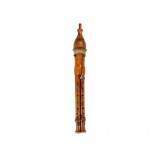Bainbridge

An English maker of flageolets and flutes and an inventor of the double, improved and flute flageolets, William Bainbridge was responsible for many innvations in the flageolet and was known for producing instruments of very high quality. There are two basic forms of the flageolet: the French, having four finger holes on the front and two thumb holes on the back; and the English, having six finger holes on the front and sometimes a single thumb hole on the back. The latter was developed by English instrument maker William Bainbridge resulting in the "improved English flageolet" in 1803. In around 1810, he patented a double flageolet, which consisted of two English flageolets joined together so that the player could harmonise the tunes that he played. He also produced a triple flageolet which added a third drone pipe which was fingered in a similar way to an ocarina.
Little is known about Bainbridge's life and not much more about his work. He trained as a wood-tuner and was active from about the turn of the century in London as a oboe, flute and flageolet player. His main interest, however was improving the English flageolet. His first patent was in 1803 for an Improved English Flageolet; and he spend much of the rest of his life working on improvements and developments for the instrument. He invented the double flageolet in about 1805 in collaboration with the Welsh musician John Parry, following performances at Covent Garden where Parry played two and even three English flageolets at once, fixed into a frame. After a number of proto-types, the design was finalised by 1806. However, Bainbridge continued to added additional features to his instrument and 15 years later invented the complex triple flageolet, where a third, bass pipe was added to the back of double instrument.

 Loading, please wait...
Loading, please wait...
